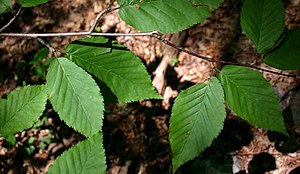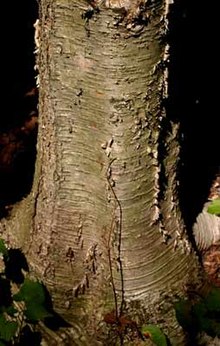Yellow birch
| Yellow birch | ||||||||||||
|---|---|---|---|---|---|---|---|---|---|---|---|---|

Yellow birch ( Betula alleghaniensis ) |
||||||||||||
| Systematics | ||||||||||||
|
||||||||||||
| Scientific name | ||||||||||||
| Betula alleghaniensis | ||||||||||||
| Britton |
The yellow birch ( Betula alleghaniensis ) belongs to the family of the birch family (Betulaceae). The German name refers to the yellowish-bronze colored bark , English names are yellow birch , gray birch , silver birch and swamp birch . The botanical name refers to a locality of the species: the Allegheny River in the USA . The yellow birch is the national tree of the Canadian province of Québec , where it is commonly called merisier , French for sweet cherry .
Plant description
The deciduous, medium-sized deciduous tree reaches heights of growth of around 20 meters (in exceptional cases up to 30 meters) and a trunk diameter of up to 80 cm. The bark is smooth, yellow to bronze in color, and flakes off in fine horizontal stripes. It is often covered with small black marks and scars. If you scratch the branches , you can smell a slight smell of methyl salicylate , but not as strong as with the sugar birch .
The root system is very adaptable and remains shallow and extensive on appropriate soils, but can also reach a depth of 1.5 meters.
The oval leaves are 6 to 12 cm long and 4 to 9 cm wide, with a double-serrated edge. The leaf tip is pointed, the leaf base rounded.
They are single sexed ( monoecious ) and wind pollinated . The inflorescences are catkins, the male seven to ten centimeters long, the female about two centimeters long. The male inflorescences are pendulous, the female erect. The inflorescences are created in the year before flowering, they unfold together with the leaves shoot at the end of May.
In autumn the many small winged seeds , which are located between the bracts in the fruit cluster, ripen . They are spread by the wind and germinate the following year.
distribution
It is a species of birch originally native to eastern North America . The distribution area extends in the north from Nova Scotia , New Brunswick and South Québec to the Appalachians and North Georgia in the south and to Minnesota in the west. The climate is temperate, the annual average temperature is around 7 ° C, at the northern limit of the area around 2 ° C. The annual precipitation ranges from 700 to 1300 mm. In the south of the distribution area, the yellow birch is increasingly restricted to higher altitudes.
The locations are well-hydrated, growing on well-drained clay soils is best. The yellow birch does not grow optimally on slightly waterlogged soils, but there is less competition there, so that there are frequent occurrences there.
ecology
The yellow birch is a slow-growing, long-lived tree species that occurs in all stages of succession in mixed forests. It grows individually or in small groups, pure yellow birch forests are rare. It is named for three forest types of the Society of American Foresters : Hemlock - Yellow Birch (Type 24), Sugar Maple - Beech - Yellow Birch (Type 25) and Red Spruce - Yellow Birch (Type 30). The tree species mentioned in these forest types are Canadian hemlock ( Tsuga canadensis ), sugar maple ( Acer saccharum ), American beech ( Fagus grandifolia ) and American red spruce ( Picea rubens ). Other tree species with which the yellow birch is associated are sugar birch ( Betula lenta ), American hop beech ( Ostrya virginiana ) and American hornbeam ( Carpinus caroliniana ).
Propagation is only possible if there are open ground and gaps in the canopy. In contrast to many other birch trees, partial shade is tolerated.
use
The wood most commonly sold as "birch" in North America is that of yellow birch. The heartwood can be light brown to deep rusty brown in color. The sapwood, which is very often sold, is lighter. The annual rings form dark lines and are therefore clearly visible. The fibers are usually straight. Wood with an irregular grain is difficult to work with. Otherwise, however, the wood of the yellow birch is considered to be well suited for turning and bending. Most of the wood is processed into plywood. Furniture is occasionally made from solid wood, but tool handles are more often made. Since the wood is abrasion-resistant, it is used, among other things, as flooring in gyms and schools. Since the wood cannot be easily preserved, it is not used for exterior constructions.
The use of the bark as medicine is reported by the Indians .
Individual evidence
- ^ EL Little: Atlas of United States Trees . 1970. Online (PDF 750kB) (accessed September 24, 2007)
- ↑ FH Eyre (ed.): Forest cover types of the United States and Canada . Society of American Foresters, Washington DC 1980, quoted in Erdmann 1990.
- ↑ Andrew Duncan, Gwen Rigby: The Hobby Carpenters - Technique of Wood Processing , German edition in cooperation with the master school Ebern for the carpentry trade, Orbis Verlag, Munich 1984, ISBN 3-572-00763-1 , p. 199
- ↑ Native American Ethobotany Database, University of Michigan Online (accessed September 24, 2007)
literature
- GG Erdmann: Yellow Birch . In: RM Burns, BH Honkala (Ed.): Silvics of North America. US Department of Agriculture, Washington 1990. ISBN 0-16-027145-2
- JJ Furlow: Betula . In: Flora of North America. Vol. 3. Oxford Univ. Press, New York 1993, pp. 516-530. ISBN 0-19-511246-6
